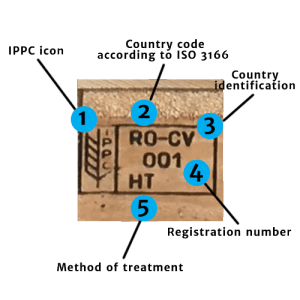One of the most widely known and used wooden packaging types – used both in warehouses and for transport – is the standard Euro Pallet (EUR 1 – 1200 x 800 mm).
ISPM 15 of the International Plant Protection Convention (IPPC) is a standard for all EPAL pallets produced by PalletBiz, and is mandatory for Euro Pallets in general. The standard allows our pallets to be used in international traffic without any restrictions.
The EPAL pallets are interchangeable and part of our “open pool”, therefore with the right handling they can be re-cycled several times.
Following this article we will answer some of the most important questions about Euro Pallets, as well as explain all crucial details about the product that you may want to know before signing up for a purchase of your own stock.
1. Why is the product called “Euro Pallet”?
In 1961 a number of European railway companies – organized within the International Union of Railways (UIC) – signed a contract for an exchangeable pallet called “Euro Pallet”. The signatory railways then became compelled to meet the standards regarding the manufacture and repair of “European pallets” and “Euro box pallets”. In the mid ’70s the Deutsche Bundesbahn (German Railways) transferred its rights to the current EPAL European Brands DB, RAL-RG 993, EUR and EPAL; and the marks were thus protected by the registered trademark. Today, this type of pallet is manufactured under different brand names in standard sizes according to EN 13698-1, and is usually offered on the market in the form of 800 mm × 1200 mm pallets, called the “Euro Pallet” by the consumer. Starting 1. August 2013, the EPAL logo inscription in the oval must appear on all edge blocks, so that it is clear that the unit is an EPAL pallet. The “EUR” labeling is no longer required.
2. In what dimensions is the Euro Pallet (EUR 1) produced?
The standard size for EUR 1 EPAL pallets is 1200 x 800 x 144 mm.
3. Are the Euro Pallets heat-treated and dried (KD)?
Yes, for Euro Pallets it is mandatory to be treated thermally, and their humidity must not be higher than 22%.
4. Is there a global/general standard for EPAL pallets?
The pallets are manufactured in accordance with strict quality regulations (UIC standard 435-2), and are periodically inspected by an independent firm. All pallets that meet the EPAL criteria are authenticated. The absence of the check and approval stamp indicates a fake pallet, which can damage the goods transported/handled by it. Transporting on an unauthenticated pallet can lead to refusal of the goods by the customers, or even to serious penalties forced by the authorities.
5. Do EPAL pallets meet the standards of all countries?
EPAL pallets comply with standards in most countries through the IPPC treatment.
6. Are Euro Pallets chemically treated?
No, these pallets are not chemically treated. There are generally two treatment methods: thermal treatment (HT) or methyl bromide fumigation. However, there are countries, e.g. Germany that do not allow fumigation treatment.
In PalletBiz, pallets are only heat treated. The hot air circulates around the pallets until a certain core temperature is reached and enough water is removed from the wood. Therefore, pallets do not contain chemicals or allergens at the end.
7. What does the stamp on the central pallet block mean? Can I check where a pallet was produced?
Please examine the following graphics:
8. What types of blocks can be used for the production of Euro Pallets?
EPAL accepts both blocks of wood and blocks of pressed sawdust.
9. How much does a Euro Pallet weigh, and what loading capacity does an EPAL pallet have?
A Euro Pallet weighs around 25 kg, and can support up to 2500 kg if loaded correctly and evenly.
10. How many pallets can fit into a 20t truck?
700 pallets can be loaded into a 20t truck (“Jumbo” trailer).
We hope that the information above will be of help to you, but if you still have unanswered questions, don’t hesitate to contact us at info@palletbz.com!
